|
September 30, 2020
I hope that you and your loved ones are doing well, staying healthy, and looking out for your neighbors and friends in these difficult times.
On the wildfire front, so far we haven’t seen any negative effects from the return of warmer, drier weather. Let’s hope that holds. We’re getting better, clearer assessments of the number of homes that were destroyed in the fires, which you’ll find further down in the newsletter. More and more people are successfully registering with FEMA and beginning to receive initial financial support.
On the COVID front, the news for today is largely good: case numbers are lower and testing numbers are higher, resulting in a low positivity rate for today at least. Unfortunately, we’re seeing higher hospitalization numbers, presumably a result of the higher number of new cases that we’ve been experiencing for the last few weeks.
For the bigger picture on COVID spread, you’ll find the summary of this week’s just-released COVID Weekly Report. It provides a clear picture of our rising case count and positivity rate over the last couple of weeks. You’ll see a new feature in this week’s weekly report: it now includes new cases for those public and private schools that are providing in-class instruction.
Again, please contact us if you have any questions about any of the information in today’s newsletter.
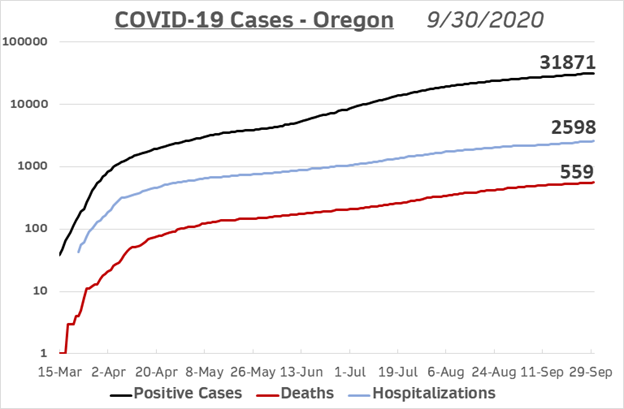
TODAY’S CORONAVIRUS AND CORONAVIRUS RESPONSE UPDATE
-
Positive Cases: OHA reports that 193 additional Oregonians have tested positive for COVID The cumulative total since the beginning of the pandemic is 31,871.
-
Total Tests: The number of reported tests has increased by 6,465. The cumulative total is now 684,235.
-
Ratio: The percentage of positive test results in Oregon is 3.0%. The national ratio today is 5.7%.
-
Deaths: I’m sorry to report 4 additional deaths due to the coronavirus today. The total number of COVID deaths in Oregon is now 559.
-
Hospitalized: OHA reports an additional 40 COVID hospitalizations today. The cumulative number of those who have been hospitalized with COVID is 2,598.
-
Presumptive Cases: OHA is including “presumptive COVID-19 cases” in its daily reports, consistent with recently amended guidance from the Centers for Disease Control and Prevention. A presumptive case is someone who does not yet have a positive PCR test but is showing symptoms and has had close contact with a confirmed case. If they later test positive by PCR, those will be recategorized as confirmed cases. OHA reports 27 new presumed positives today. There are currently 1,638 Oregonians who have been presumed positive for COVID-19.
-
Other Hospital Information:
- Patients Currently w COVID-19 Symptoms (who may or may not have received a positive test result yet): 170 (3 fewer than yesterday). Of those, 127 have already received a positive test back.
- Available ICU Beds: 163 (26 fewer than yesterday)
- Other Available Beds: 636 (143 fewer than yesterday).
- ICU Patients w COVID-19 Symptoms: 48 (5 fewer than yesterday).
- COVID-19 Patients Currently on Ventilators: 14 (3 fewer than yesterday).
- Available Ventilators: 802 (16 fewer than yesterday).
-
Dashboards
-
Today’s National Numbers:
-
Additional Brief Updates:
- The Malheur Enterprise has a story about the explosion of COVID cases at the Snake River Correctional Institution, where infections among adults in custody have nearly doubled over the last month. Nearly four hundred adults in custody (394 to be exact) at the state prison in Ontario have already tested positive for COVID, as have 139 correctional officers. These are numbers that are orders of magnitude above the infection rate in the general population. Four AICs at Snake River have died of COVID so far.
- A reminder that the Division of Financial Regulation and the Insurance Commissioner are holding an Insurance Town Hall tomorrow, October 1, at noon. It’s an opportunity for those affected by the wildfires to find out how to navigate the process for obtaining the support that they are owed.
- A FEMA External Outreach Center will open tomorrow in Medford to assist the many residents in Jackson County affected by the recent wildfires. The center will accommodate in-person visits, where residents can get information about their application, ask questions about letters they receive from FEMA and have their documents scanned into their case file. The center will be open 8 a.m. to 6 p.m., seven days a week. Here’s more information about it in English and in Spanish.
- The Latino Network is working with OHA and the Multnomah County Public Health Department to put on a COVID testing drive for area Latinx residents this Thursday and Saturday in Portland. As you know, case numbers are especially high among the Latinx community, and this is an effort to help counter that spread. OPB has a story about it.
- As I’m sure you’ve observed, there are plenty of myths and rumors out there about COVID. The Oregon Pediatric Society (OPS) addresses the issue in a recently-published article, “Rumors I’ve heard about COVID-19 – Myth or Fact?” The authors, Megan Jacobs, MD, MSCS, and Jessica Serrano, MD, MPH, are adolescent medicine pediatricians at Oregon Health & Science University. You can find the full article on the OPS website. The World Health Organization also hosts a myth-buster page.
OHA Releases Updated Tracking Report for School Reopening Metrics
OHA has just published the latest data on how the state as a whole and individual counties are doing in terms of meeting school reopening metrics. These data are updated each week.
You can find explanatory information about the metrics here.
With the recent increases in cases around the state, fewer counties will unfortunately be able to meet the threshold for reopening in-person K-3 instruction. However, those districts that are already offering in-person K-3 instruction should be able to continue to do so, at least for now.
Latest OHA Weekly COVID Report Released
OHA released its WEEKLY COVID REPORT today. It is again a very comprehensive snapshot of different aspects of transmission of the disease in Oregon over the past week or so. It confirms what we’ve been seeing in our daily reports: an ongoing reduction of transmission in Oregon, with declines in new infections, accompanied by declining testing and increases in test positivity, hospitalizations, and declining deaths. It continues to show ongoing disproportionality among racial and ethnic groups.
Here are some of OHA’s broad observations of where we are now, based on data from September 21-27:
- We are now seeing even bigger increases in the number of new cases. Last week OHA recorded 1,999 new cases of COVID-19 infection—up 32% from the previous week’s tally of 1,511. This brings to an end 6 weeks of declining case counts.
- The statewide infection rate is now 779 cases per 100,000 Oregonians.
- Last week’s testing numbers rose by 29% to 24,243. That number will go up as more results come in for last week, but even when those numbers are added, it will be clear that we continue to test well below our capacity. Some of this is likely due to the wildfires, but definitely not all.
- The percentage of positive test results is the same as it was last week: an average positivity rate of 6.2% for the week.
- Last week the number of reported deaths was the same as it had been the previous week: 18.
- The cumulative death rate since the beginning of the pandemic is 12.9 deaths per 100,000 Oregonians, with a cumulative total of 547 on September 27. This remains a mortality rate of 1.7% of reported cases.
- The number of new COVID hospitalizations rose last week, 143 vs. the previous week’s 116.
- The age group with the highest incidence of reported infection continues to be 20–29-year-olds, with rates decreasing in subsequent decades of life.
The report again provides information about signs, symptoms, and risk factors; racial/ethnic/age/gender demographics; recovery; outbreaks in long-term care; workplace outbreaks; hospital rates; and the breakdown of cases by zip code.
Racial/Ethnic
The report again demonstrates significant disparities among racial groups. You can see this in the charts below, with data that I’ve taken from the August 19 report, the August 26 report, and from this report. It allows you to see at a glance the proportion of case counts within different racial groups and ethnic groups (technically, “Hispanic” is not a race and is counted as an ethnic group, with numbers from a separate chart). They remain relatively stable.
You’ll see again how much higher the rates per 100,000 are for most racial/ethnic groups compared to White Oregonians. Black Oregonians are 3.6 times more likely to contract the disease than are White Oregonians, Native Americans 4.4 times more likely, Latinx Oregonians are 6.1 times more likely, and Pacific Islanders are now 9.3 times more likely. The differences, while still enormous, have been going down slightly over the last few weeks.
You’ll also again see that the percentages of those who contract the disease and then are hospitalized for it are somewhat lower for Blacks and Native Americans, quite a bit lower for Latinx, and quite a bit higher for Pacific Islanders than for the population of White Oregonians. The percentage of those who contract the disease and ultimately die of it is much higher for Whites than for people of color.

The weekly report includes graphs showing how Public Health agencies are doing in contact tracing for different racial and ethnic groups. For the most part, attempts at initial interviews and follow-ups with Oregonians of color appear to be comparable with White (actually, higher among Hispanic). Those attempts are less successful for Black Oregonians.
Outbreaks at Long-Term Care Facilities
The report lists outbreaks at long-term care facilities with more than five residents that have three or more confirmed cases or at least one COVID death. Fortunately, we are seeing a continued reduction in active outbreaks in these facilities.
This week’s report lists outbreaks in 34 (up from 32) long-term care facilities that are still considered active. They are responsible for 625 cases (up from 556) and 44 deaths (down from 48).
In addition, there are 60 outbreaks considered resolved (up from 54). They are responsible for 890 cases (up from 803) and 89 deaths (up from 78). To be listed as a “resolved” outbreak, a facility must not have had a new case in at least 28 days.
The total for the 86 active and resolved facilities on the lists this week is thus 1,515 cases and 133 deaths.
Facilities that have been in “resolved” status for 56 days are being dropped from that list. So, the totals are obviously not the totals since the beginning of the pandemic.
In addition to the listed facilities, there are now 48 (the same number as last week) congregate settings with five or fewer beds that have also had three or more confirmed cases or one or more deaths, so the above totals should actually be somewhat higher.
To date, there has still been only one death of a staff member reported.
Workplace Outbreaks
Similarly, there are separate listings for workplace outbreaks that are “active” and “resolved,” but without deaths identified by workplace. Case counts include all persons linked to the outbreak, which may include household members and other close contacts. To protect privacy, OHA is only reporting workplace outbreaks with five or more cases (workers and family members) and only for workplaces with at least 30 workers. They are listed in descending order of number of cases.
You’ll find 61 workplaces (up from 60 last week) listed as “Active” this week, totaling 2,173 (down from 2,214 last week).
A facility goes onto the resolved list once it has not had a new case in 28 days.
55 workplaces (down from 59 last week) are now listed as “Resolved,” totaling 847 cases (up from 745 last week).
As is the case with the long-term care lists, once a workplace outbreak has been in resolved status for 56 days, it is dropped from the list.
The total number of cases for both is thus 3,030.
So far, nine deaths have been the result of workplace outbreaks.
Three out of the top four workplace outbreaks in Oregon today are again in Eastern Oregon state prisons. They make up 41% of all the active workplace outbreak cases.
Childcare Outbreaks
OHA has changed the way that it reports outbreaks in childcare facilities. Previously, the Weekly Report only included names and case counts for childcare facilities that enroll 30 or more children and have five or more cases. They are now reporting all outbreaks that include two or more cases in facilities with 16 or more children. As a result, we now have seven facilities listed as active. They are located in Salem, Gresham, Eugene, Ontario, Beaverton, and Nyssa. They comprise a total of 42 cases.
These case counts may include children, staff, and household members.
Cases in K-12 Schools
OHA has added a new feature to the weekly report. It is now reporting all COVID-19 cases in schools that offer in-person instruction, distinguishing between students and staff.
For reporting purposes, OHA will treat schools that have no students being served onsite as workplace outbreaks, and will be reported in that section. OHA will report outbreaks of COVID-19 when five or more cases are identified in a school that has 30 or more employees.
The new reporting protocol applies to all public and private schools and programs.
This week’s report on schools with in-person instruction shows five cases of students and six cases of staff at a total of six public and private schools around the state (in The Dalles, Irrigon, Milton-Freewater, Brookings, North Bend, and Sutherlin).
Infections by Zip Code
You’ll see that the zip code list again reveals the various hot spots around the state, presented in terms of cases per 10K residents since the beginning of the pandemic. The top five are exactly the same (from Umatilla/Morrow, Jefferson, and Malheur Counties) as they’ve been for the last few weeks, but Ontario in Malheur County has moved up to #3:
- 97818 (Boardman in Morrow County)
- 97761 (Warm Springs in Jefferson County)
- 97914 (Ontario in Malheur County)
- 97838 (Hermiston in Umatilla and Morrow Counties)
- 97882 (Umatilla in Umatilla County)
97875 (Stanfield in Umatilla County) remains on deck at a distant #6.
Here is a zip code locator for you to use as you look at the zip code numbers.
Wednesday Wildfire Update
Although much of the state is experiencing higher than usual temperatures, we’ve not seen harmful effects on the existing wildfires or potentially new fires.
Below again are two tables showing further progress on two of the major fires, one showing containment and acres burned yesterday and the other for today.
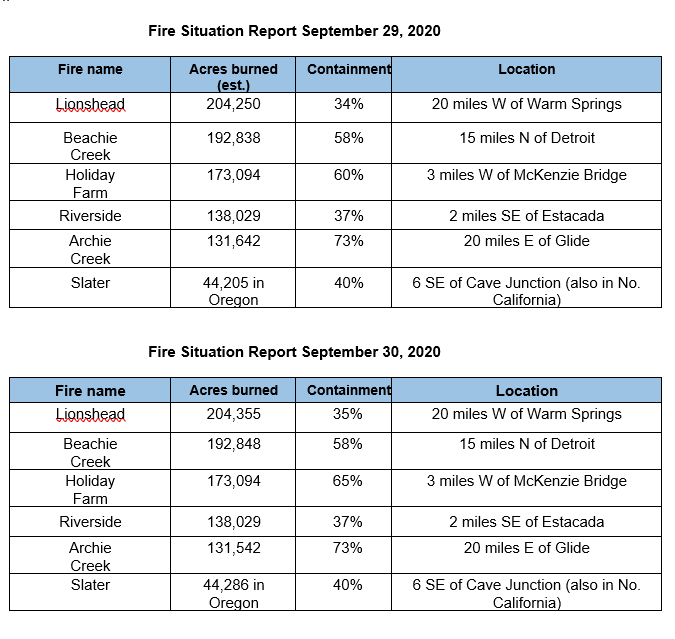 Again, for maps and up-to-the-minute details on the individual fires, I’d direct you to OEM’s State of Oregon Fires and Hotspots Dashboard.
- There have been more than 7,500 personnel from 39 states and multiple Canadian provinces assigned to fires in Oregon since Labor Day. This number doesn’t include many of the government employees, landowners, forestland operators, and members of the community who fought alongside and supported firefighting personnel over the past few weeks.
- I’m happy to report that the number of people confirmed fatalities remains at 9, while the number of those confirmed missing also remains at 9.
- As I mentioned yesterday, the number of dwellings and other structures reported destroyed has been adjusted downward. We received the reason for that this afternoon. OEM is now integrating damage assessment information from various data sources, including impacted counties, the Office of Oregon State Fire Marshal, American Red Cross, and others. This updated process provides a more accurate picture, as local jurisdictions are able to do more thorough in-person assessments. Here are the latest numbers, broken down more precisely into types of residence:
- Residences destroyed: 3,124
- Single Family: 1,069
- Multi-Family (Apartment): 197
- Manufactured Homes: 1,858
- Other structures destroyed: 1,403
- Another 200 Oregonians have successfully registered with FEMA for individual assistance over the last 24 hours, bringing the total number to 6,221 households that have already had their applications approved. $13.2 million dollars has already been approved for distribution.
- Assistance provided by FEMA for homeowners can include grants for repairs to make their primary home habitable. Rental assistance is available to pay for temporary housing for homeowners and renters. Assistance can also help with other disaster-related needs like replacing essential household items, medical and dental expenses.
- In addition to FEMA grants, the U.S. Small Business Administration (SBA) offers low-cost disaster loans for homeowners, renters, and businesses. This includes Economic Injury Disaster Loans (EIDLs) for small businesses. Anyone seeking an SBA disaster loan need to register with FEMA first.
- Again, if you know of anyone who has NOT yet registered, please direct them to the following:
- Roughly 47 miles of Oregon highway remain closed, down from a peak of 244, and roughly 43 miles are open to piloted traffic only. In the last week, imminent threat trees (those that pose the greatest risk of falling) were removed in 95 miles of damaged area. While removing imminent threat trees has been a priority and must be done before other repairs, crews are also assessing culverts, guardrail, pavement, slopes, signs and equipment for damage.
- You can find an up-to-the-moment status report on road closures from ODOT’s Trip Check tool.
Wildfire Informational Resources
Here again are some other resources that I would recommend:
- Again, for one-stop information about fires, firefighting response, smoke levels, relief for evacuees, and much more, you can find a variety of Wildfire-related Resources at the Governor’s Wildfire Website. I really encourage you to check this one out first—there’s a wealth of info and links here, including on how to volunteer, donate, or otherwise help.
- For the daily informational releases on the major fires, go to the ODF Wildfire News Page.
- Here are regular updates on road conditions from ODOT.
- The Office of Emergency Management provides regular updates at the OEM Twitter page and at the OEM Facebook page.
Additional Wildfire News
Where Are Today’s New Cases?
If we put together the positive test results and new “presumptive” cases reported today, the overall number of new cases is 220. Two-thirds of today’s cases are from outside the Portland Tri-County area. Here is the breakdown by county for today:
Baker (3)
Benton (4)
Clackamas (17)
Clatsop (3)
Columbia (2)
Coos (2)
Deschutes (14)
Douglas (4)
Jackson (19)
Josephine (1)
Lake (1)
Lane (29)
Linn (7)
Malheur (8)
Marion (35)
Morrow (4)
Multnomah (20)
Umatilla (6)
Wallowa (1)
Washington (35)
Yamhill (5)
And the Deaths
Oregon’s 556th COVID-19 death is a 69-year-old man in Clackamas County who tested positive on Sept. 15 and died on Sept. 24 at Kaiser Sunnyside Medical Center.
Oregon’s 557th COVID-19 death is an 85-year-old woman in Wasco County who tested positive on Sept. 18 and died on Sept. 27 in her residence.
Oregon’s 558th COVID-19 death is an 86-year-old woman in Marion County who died on Aug. 25 in her residence.
Oregon’s 559th COVID-19 death is a 61-year-old man in Jackson County who tested positive on Sept. 21 and died on Sept. 28 at Asante Rogue Regional Medical Center.
Additional Graphs:
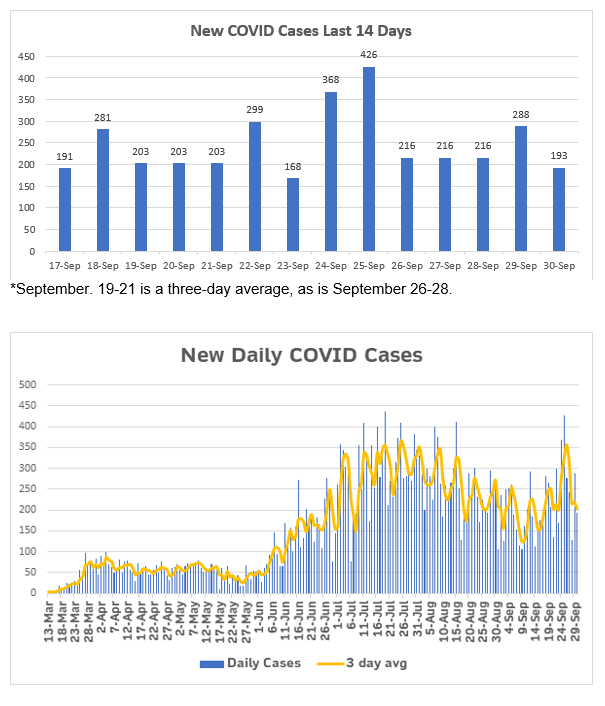  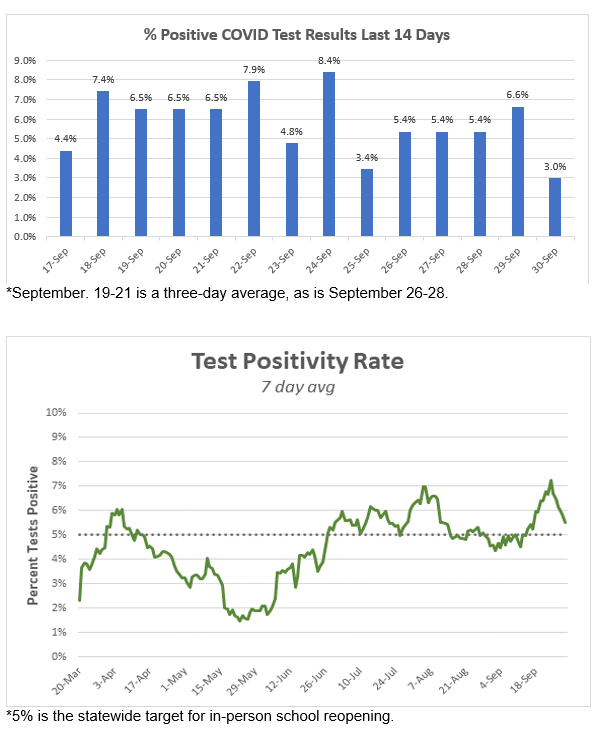  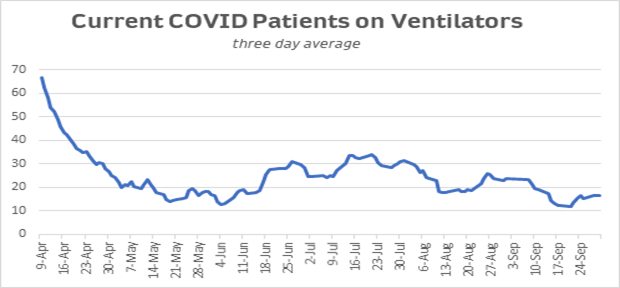
Want to See Past Newsletters?
If there was COVID-related information in a past newsletter that you want to go back to, but find you’ve deleted it, you can always go to my legislative website (senatordembrow.com), click on “News and Information,” and you’ll find them all there. Also, if someone forwarded you this newsletter and you’d like to get it directly, you can sign up for it there.
AND FINALLY,
Here again are some resources that you will find useful:
If the above links are not providing you with answers to your questions or directing you to the help that you need, please consider me and my office to be a resource. We’ll do our best to assist you or steer you in the right direction.
Best,
 Senator Michael Dembrow
District 23
email: Sen.MichaelDembrow@oregonlegislature.gov
web: www.senatordembrow.com
phone: 503-986-1723
mail: 900 Court St NE, S-407, Salem, OR, 97301
|